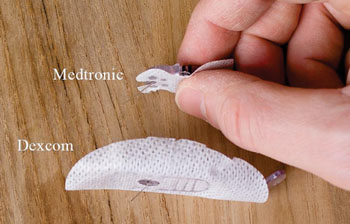Continuous Glucose Monitoring Sensors Compared for Effectiveness
By LabMedica International staff writers
Posted on 02 Oct 2014
A continuous glucose monitor, a tool used in optimizing glycemic control in patients with type 1 diabetes, is a subcutaneous tissue sensor that provides an interstitial fluid glucose measurement every one to five minutes.Posted on 02 Oct 2014
The simultaneous use of two popular continuous glucose monitoring (CGM) sensors revealed clear differences in their accuracy and in patient-rated treatment experiences, including ease of use, feelings of safety, and willingness to use the system in daily life.

Image: Two popular continuous glucose monitoring (CGM) sensors compared (Photo courtesy of Broken Pancreas).
Scientists at the University of Gothenburg (Sweden) working with their North American colleagues enrolled 38 patients who met the inclusion criteria for the study. The mean age was 50 years, 66% were men, and mean diabetes duration was 22.9 years. The mean HbA1c level was 58.9 mmol/mol or 7.5%. Patients were educated on how to use the CGM sensors, and the sensors were calibrated. All participants were educated on use of the HemoCue (Ängelholm, Sweden) analyzer and cuvettes and were advised to measure capillary glucose values six to 10 times per day.
The 38 ambulatory patients with type 1 diabetes used the Dexcom G4 PLATINUM (San Diego, CA, USA) and the Enlite Guardian REAL-Time System (Medtronic MiniMed, Inc.; Northridge, CA, USA) CGM sensors simultaneously for a minimum of four and maximum of six days. The mean absolute relative difference (MARD) in blood glucose for the Dexcom G4 was significantly lower (13.9%) than for the Enlite sensor (17.8%) among a total of 1,012 sets of measurements. For glucose levels in the hypoglycemic range of less than 4.0 mmol/L, the MARD for the Dexcom G4 was 20.0% compared with 34.7% for the Enlite. More patients rated their experience with the Dexcom G4 as positive and preferred to use it in their daily lives.
The authors concluded that the Dexcom G4 CGM system showed greater accuracy than the Enlite system, and patients had a significantly more positive treatment experience. The findings indicate that the Dexcom G4 is more optimal when dosing insulin, when taking other treatment actions, and in avoiding hypoglycemia. The results also indicate that the Dexcom G4 may make it possible for more patients to wear a CGM device for a longer period of time. These findings should be considered by treatment providers when recommending suitable CGM systems and evaluating ongoing therapies. The study was published on September 18, 2014, in the journal Diabetes Technology & Therapeutics.
Related Links:
University of Gothenburg
HemoCue
Dexcom














